power steering AUDI A8 2013 User Guide
[x] Cancel search | Manufacturer: AUDI, Model Year: 2013, Model line: A8, Model: AUDI A8 2013Pages: 318, PDF Size: 79.34 MB
Page 111 of 318
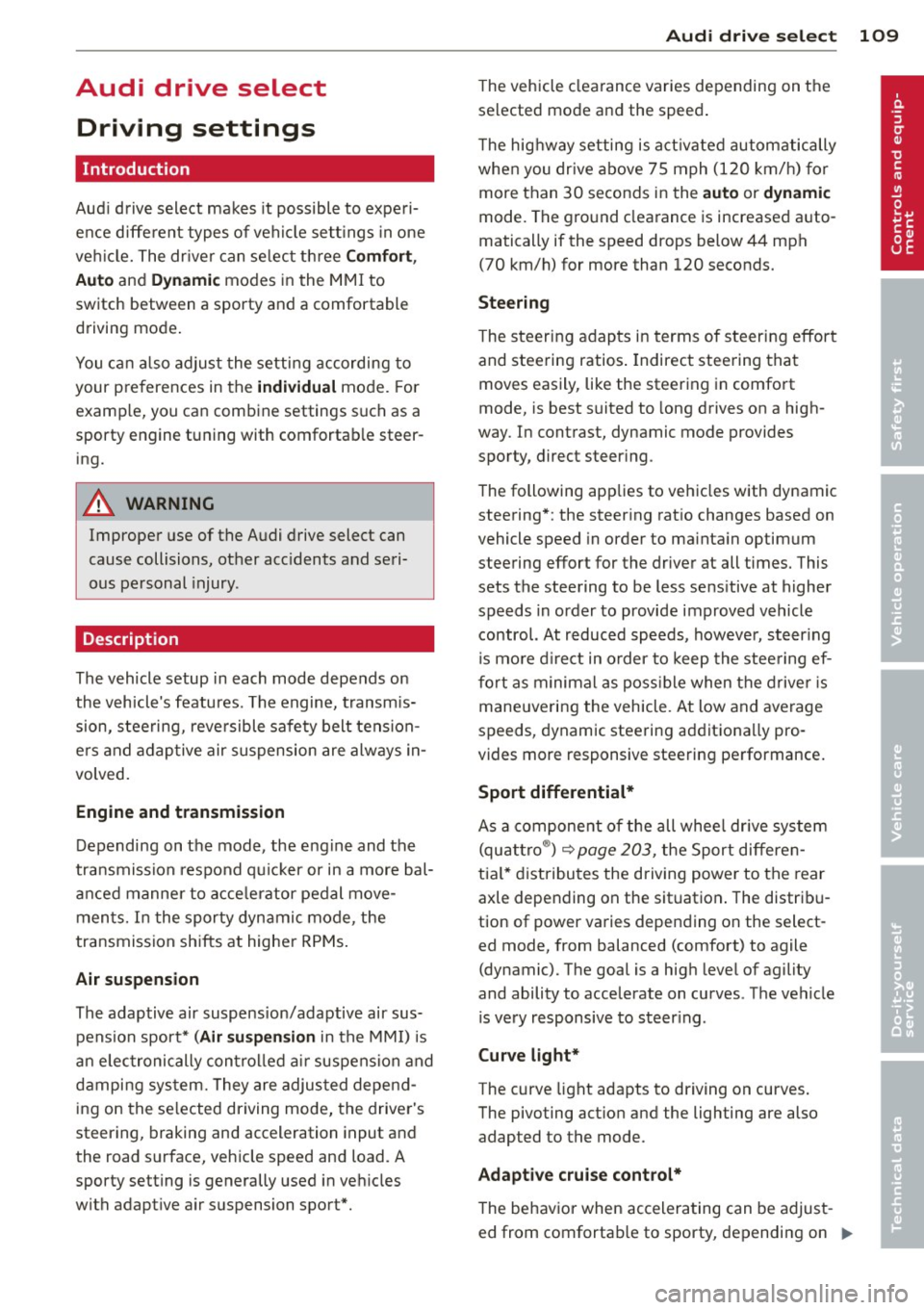
Audi drive select Driving settings
Introduction
Aud i drive select makes it possible to experi
ence different types of vehicle settings in one
veh icle. The driver can select th ree
Comfort,
Auto
and Dynamic modes in the MMI to
switch between a sporty and a comfortable
driving mode.
You can also adjust the setting according to
your preferences in the
individual mode. For
examp le, you can combine settings such as a
sporty engine tuning with comfortab le steer
ing.
A WARNING
Improper use of the Audi drive select can
cause collisions, other acc idents and seri
ous personal injury .
Description
The vehicle setup in each mode depends on
the vehicle's features. The engine, transm is
sion, steering, reve rsible safety belt tension
ers and adaptive air suspension are always in
volved.
Engine and transmission
Depending on the mode, the engine and the
tra nsmission respond quicker or in a more bal
anced manne r to acce lerator pedal move
ments. In the sporty dynamic mode, the
transmission shifts at higher RPMs .
Air suspension
The adaptive air suspension/adaptive air sus
pension sport*
( Air suspension in the MMI) is
an electronically con trolled air suspension and
damping sys tem. They are adjusted depend
ing on the selected driving mode, the drive r's
steering, braking and acceleration input and
the road s urface, vehicle speed and load. A
sporty setting is generally used in vehicles
with adaptive air suspension sport*.
Audi drive select 109
The vehicle clearance varies depending on the
selected mode and the speed .
T he hig hway setting is activated automatically
when you drive above 75 mph (120 km/h) for
more than 30 seconds in the
auto or dynamic
mode. The ground clearance is increased auto
matically if the speed drops below 44 mph
(70 km/h) for more than 120 seconds.
Steering
The steering adapts in terms of steering effort
and steering ratios . Indirect stee ring that
moves easily, like the steering in comfort
mode, is best suited to long drives on a high
way . In contrast, dynamic mode provides
sporty, direct steer ing .
The following applies to vehicles with dynamic steering* : the steering ratio changes based on
vehicle speed in order to ma inta in optimum
steering effort for the driver at all times. This
sets the steering to be less sens itive at higher
speeds in order to provide improved vehicle
control. At reduced speeds, however, steer ing
is mo re direct in order to keep the steering ef
fort as minimal as possible when the driver is
maneuvering the vehicle. At low and average
speeds, dynamic steering additiona lly pro
vides more responsive steering performance.
Sport differential*
As a component of the all whee l dr ive system
(quattro ®)
<:!) page 203, the Sport differen
tia l* distributes the driving power to the rear
axle depending on the situation . The distribu
tion of power varies depending on the select
ed mode, from balanced (comfort) to agile
(dynamic). The goal is a high level of agility
and ability to accelerate on curves . The vehicle
is very responsive to steering.
Curve light*
The curve light adapts to driving on curves.
The pivoting act ion and the lighting are also
adapted to the mode.
Adaptive cruise control*
The behavior when accelerating can be adjust
ed from comfortab le to sporty, depending on .,..
Page 200 of 318
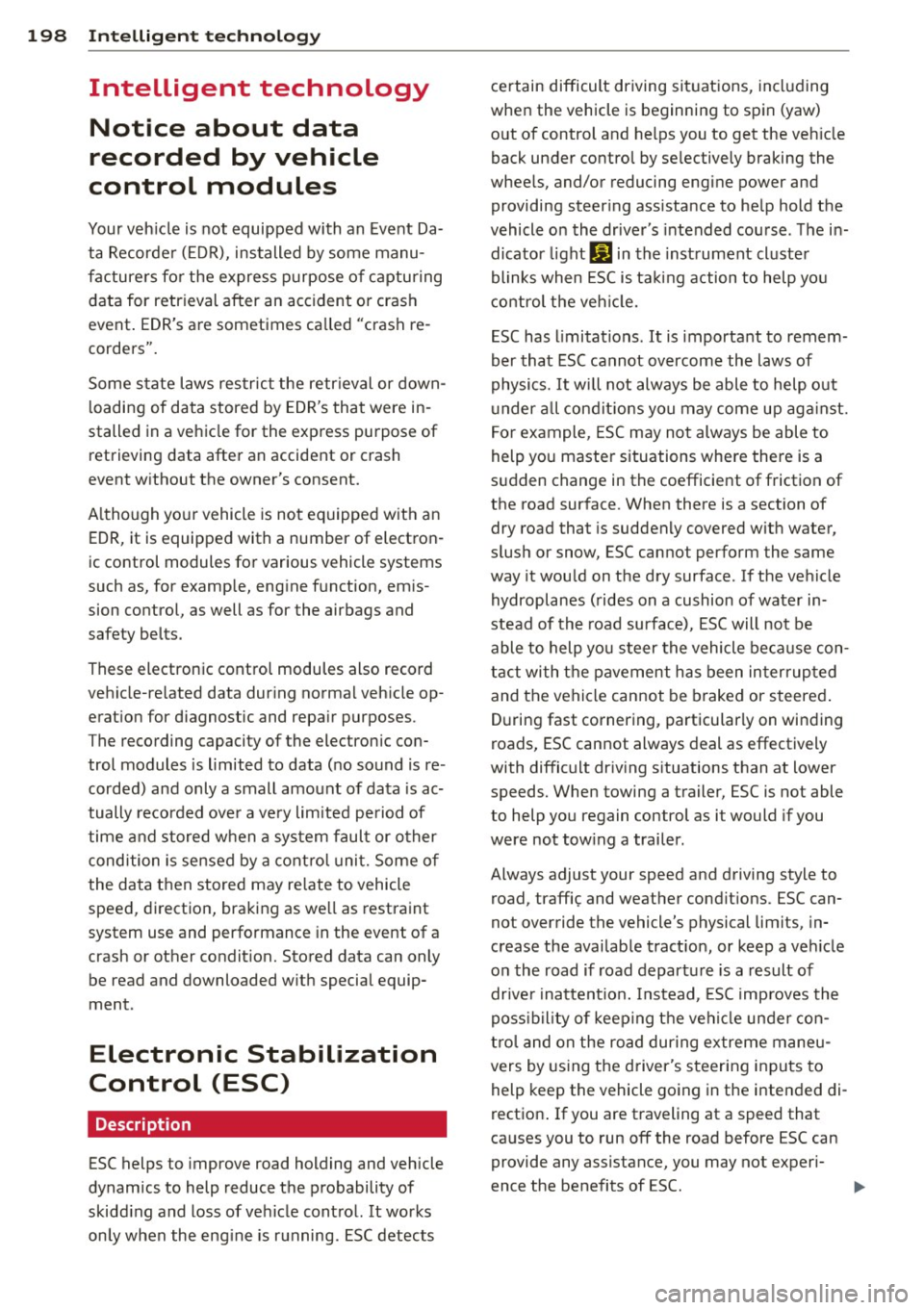
198 Intellige nt tec hno logy
Intelligent technology
Notice about data
recorded by veh ic le
control modules
Your vehicle is not equipped with an Event Da
ta Recorder (EDR), installed by some manu
facturers fo r the express purpose of capturing
data for retrieval after an accident or crash
event . EDR's are sometimes called "crash re
corders".
Some state laws restrict the retrieval or down
loading of data stored by EDR's that were in
stalled in a vehicle for the express purpose of
retrieving data after an accident or crash
event without the owner's consent.
A lthough your vehicle is not equipped with an
EDR, it is equipped with a number of electron
ic control modules for various vehicle systems
such as, for example, engine function, emis
sion control, as well as for the airbags and
safety belts.
These electronic control modules also record
vehicle-related data during normal vehicle op
eration for diagnostic and repair purposes.
The recording capacity of the electronic con
trol modules is limited to data (no sound is re
corded) and only a small amount of data is ac
tually recorded over a very limited period of
time and stored when a system fault or other
condition is sensed by a control unit. Some of
the data then stored may relate to vehicle
speed, direction, braking as well as restraint
system use and performance in the event of a
crash or other condition. Stored data can only
be read and downloaded with special equip
ment.
Electronic Stab ilization
Control (ESC)
Description
ESC helps to improve road holding and vehicle
dynamics to help reduce the probability of
skidding and loss of vehicle control. It works
only when the engine is running. ESC detects certain difficult driving situations, including
when the vehicle is beginning to spin (yaw)
out of control and helps you to get the vehicle back under control by selectively braking the
wheels, and/or reducing engine power and
providing steering assistance to help hold the
vehicle on the driver's intended course. The in
dicator light
G) in the instrument cluster
blinks when ESC is taking action to help you
control the vehicle.
ESC has limitations.
It is important to remem
ber that ESC cannot overcome the laws of
physics. It will not always be able to help out
under a ll cond itions you may come up against.
For example, ESC may not always be able to
help you master situations where there is a
sudden change in the coefficient of friction of
the road surface. When there is a section of
dry road that is suddenly covered with water,
slush or snow, ESC cannot perform the same
way it would on the dry surface . If the vehicle
hydroplanes (rides on a cushion of water in
stead of the road surface), ESC will not be
able to help you steer the vehicle because con
tact with the pavement has been interrupted
and the vehicle cannot be braked or steered.
During fast cornering, particularly on winding
roads, ESC cannot always deal as effectively
with difficult driving situations than at lower
speeds. When towing a trailer, ESC is not able
to help you regain control as it would if you
were not towing a trailer.
Always adjust your speed and driving style to road, traffic; and weather conditions. ESC can
not override the vehicle's physical limits, in
crease the available traction, or keep a vehicle
on the road if road departure is a result of
driver inattent ion. Instead, ESC improves the
possibility of keeping the vehicle under con
trol and on the road during extreme maneu
vers by using the driver's steering inputs to
help keep the vehicle going in the intended di
rection . If you are traveling at a speed that
causes you to run off the road before ESC can
provide any assistance, you may not experi
ence the benefits of ESC.
Page 201 of 318
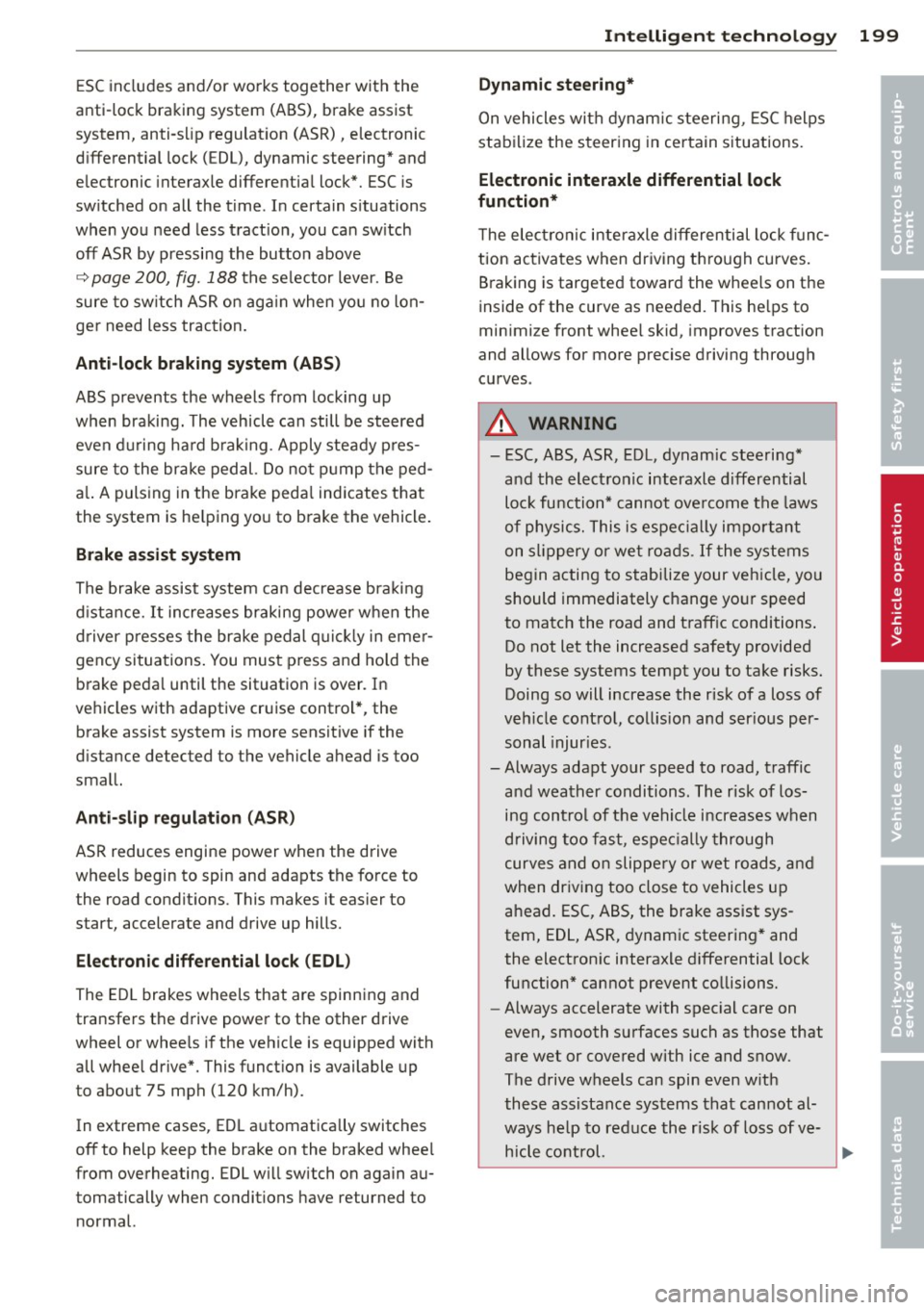
ESC includes and/or works together with the
anti-lock braking system (ABS), brake assist
system, anti-s lip regulat ion (ASR), electronic
d ifferential lock (EDL), dynamic steering* and
electronic interaxle differential lock*. ESC is
sw itched on all the time . In certain s ituations
when you need less tract ion, you can sw itch
off ASR by pressing the button above
~ page 200, fig. 188 the se lector lever. Be
sure to sw itch ASR o n aga in when yo u no lon
ger need less traction.
Anti -lock braking system (ABS)
ABS prevents the wheels from locking up
when braking. The veh icle can still be steered
even du ring ha rd b raking . Apply steady p res
sure to the brake pedal. Do not p ump the ped
a l. A pulsing in the brake peda l indicates that
the system is he lping you to brake the vehicle .
Brake as sist system
The brake assist system can decrease bra king
d istance.
It increases braking power when the
driver presses the brake pedal qu ick ly in eme r
gency situations . You must p ress and ho ld the
brake peda l until the situation is over. In
vehicles with adaptive cruise control*, the
brake assist system is more sensit ive if the
d istance detected to the vehicle ahead is too
small.
Anti- slip regulati on (A SR )
ASR reduces engine power when the drive
wheels begin to spin and adapts the force to the road condit ions. This makes it eas ier to
start, accelerate and drive up hills.
Electronic diff erential lo ck (EDL )
The ED L brakes wheels that are spinning and
transfers the drive power to the other drive
wheel or whee ls if the vehicle is equipped with
all whee l drive*. This funct ion is available up
to about 75 mph (120 km/h).
In extreme cases, EDL automatica lly switches
off to help keep the brake on the braked whee l
from overheating. EDL w ill switch on again au
tomatically when conditions have returned to normal.
Int ellig ent technolog y 199
Dynamic ste ering *
On vehicles with dynam ic steering, ESC helps
stabilize the steering in certain situations.
Electronic intera xle differential l ock
function*
T he electron ic i nteraxle differential lock f unc
tion activa tes when dr iving th ro ugh curves.
Braking is targeted toward the wheels on the
inside of the curve as needed. This he lps to
minimize front whee l skid, improves traction
and allows for more precise driving through curves .
A WARNING
- ESC, ABS, ASR, EDL, dynamic steering*
and the elect ronic interaxle differential
loc k function* cannot ove rcome the laws
of physics. This is espec ially important
on slippery or we t roads.
If the systems
begin acting to stabilize your veh icle, you
should immediately change yo ur speed
to match the road and traffic conditions .
Do not let the increased safety provided
by these systems tempt you to take risks.
Doing so will increase the risk of a loss of
veh icle contro l, collision and ser ious per
sonal injur ies.
- Always adapt your speed to road, traffic and weather conditions. The risk of losing con trol of the vehicle increases when
driving too fast, espe cially through
curves a nd on slippe ry or wet roads, and
when dr iving too close to vehicles up
ahead. ESC, ABS, the brake assist sys
tem, EDL, ASR, dynam ic steering* and
the electron ic interaxle d ifferential lock
function" cannot prevent co llisions.
- Always accelerate with spec ial care on
even, smooth surfaces such as those that
are wet or covered with ice and snow.
The drive wheels can spin even w ith
these assistance systems that cannot al
ways he lp to red uce the risk of loss of ve
hicle control.
-
•
•
Page 204 of 318
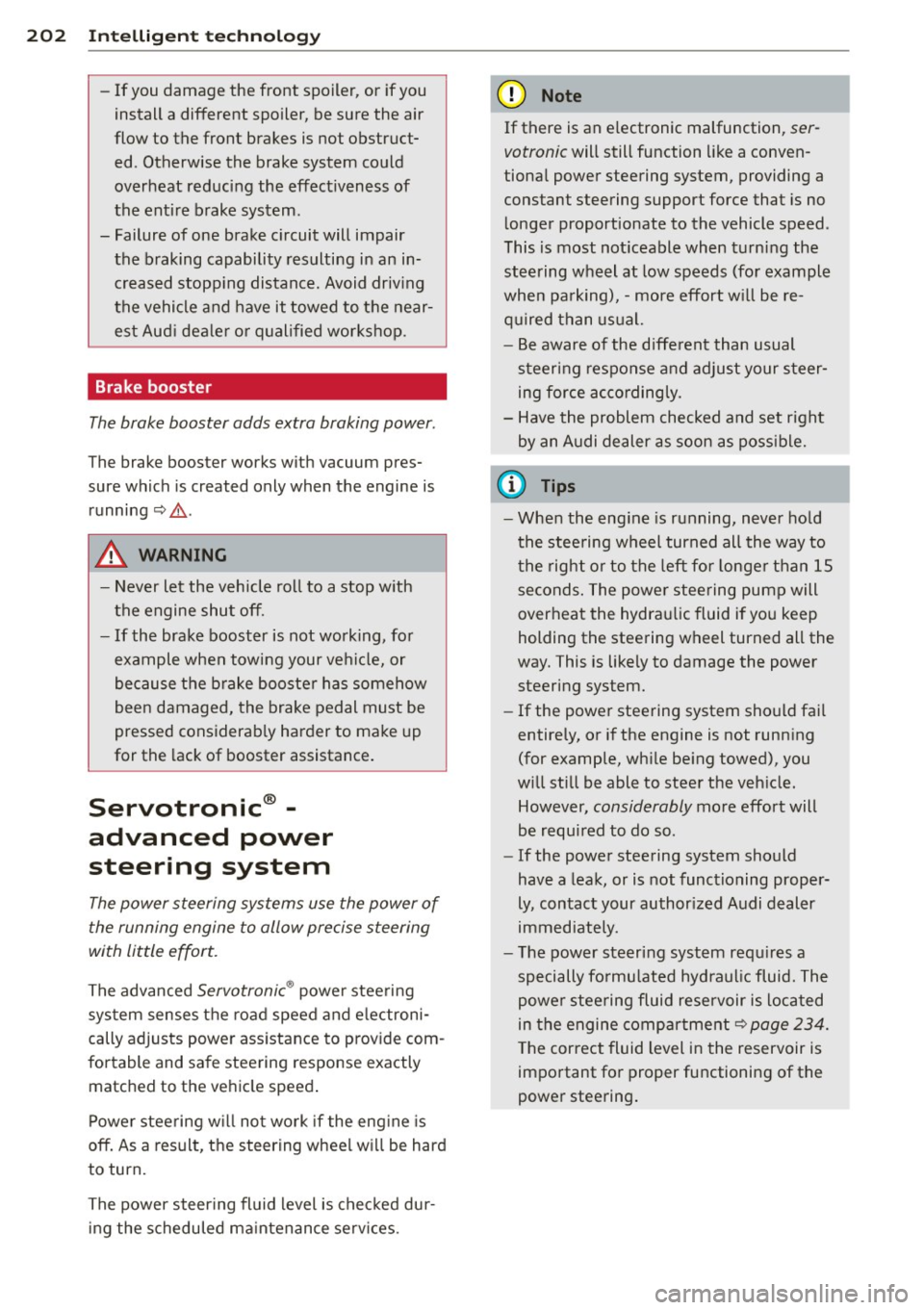
202 Intellig ent technol ogy
- If you damage the fro nt spoiler, or if you
install a different spoiler, be sure the air
flow to the front brakes is not obstruct ed . Otherwise the brake system could
overheat reducing the effectiveness of
the ent ire brake system .
- Failure of one brake c ircuit will impair
the braking capability resulting in an in creased stopp ing distance. Avoid driv ing
the vehicle and have it towed to the near est Aud i dea ler or qualified workshop .
Brake booster
The brake booster adds extra braking power .
The brake booster works with vacuum pres
sure which is created only when the engine is
running ¢& .
& WARNING
-Never let the vehicle ro ll to a stop w ith
the engine shut off.
- If the brake booster is not work ing, for
example when towing your vehicle, or
because the b rake booste r has somehow
been damaged, the brake pedal must be
pressed considerab ly harder to make up
for the lack of booster assistance .
Servotronic® -
advanced power
steering system
The power steering systems use the power of
the running engine to allow precise steering
with little effort.
The advanced Servotronic ® power steering
system senses the road speed and e lectroni
cally adjusts powe r ass istance to p rov ide com
fortable and sa fe stee ring response exactly
matc hed to the ve hicle speed .
Power steering w il l not work if the eng ine is
off . As a result, the steering whee l w ill be hard
to turn.
The power steering fluid level is chec ked dur
ing the scheduled ma intenance serv ices.
(D Note
If there is an e lectronic malfunction, ser
votronic
will still function like a conven
tiona l power steering system, providing a
constant steering support force that is no
l onger proportionate to the vehicle speed.
This is most not iceable when t urning the
steering wheel at low speeds (for example
when pa rking), - more effort w ill be re
q uired than us ual.
- Be aware of the diffe rent than usual
steering response and adjust your steer
ing force acco rding ly.
- Have the problem checked and set right
by an A udi dealer as soon as poss ible.
(D Tips
- When the eng ine is running, never ho ld
the stee ring wheel turned all the way to
the rig ht or to the left fo r longer than 15
seconds. The powe r stee ring pump will
overheat the hydraulic fluid i f yo u keep
holding the stee ring wheel turned all the
way. This is likely to damage the power steering system.
- If the powe r steering system sho uld fai l
entire ly, or if the engine is not runn ing
(for example, wh ile be ing towed), you
w ill still be able to stee r the veh icle.
However,
considerably more effort will
be requi red to do so.
- If the power steering system should
have a leak, or is not functioning proper
ly, contact your author ized Audi dealer
immed iately.
- The power steer ing system req uires a
specially fo rmu lated hyd raulic fluid. The
powe r stee ring fluid reservoir is located
in the engine comp art ment¢
page 234.
T he cor rect fluid level in the reservoir is
impo rtant fo r proper functioning of the
powe r stee ring .
Page 237 of 318
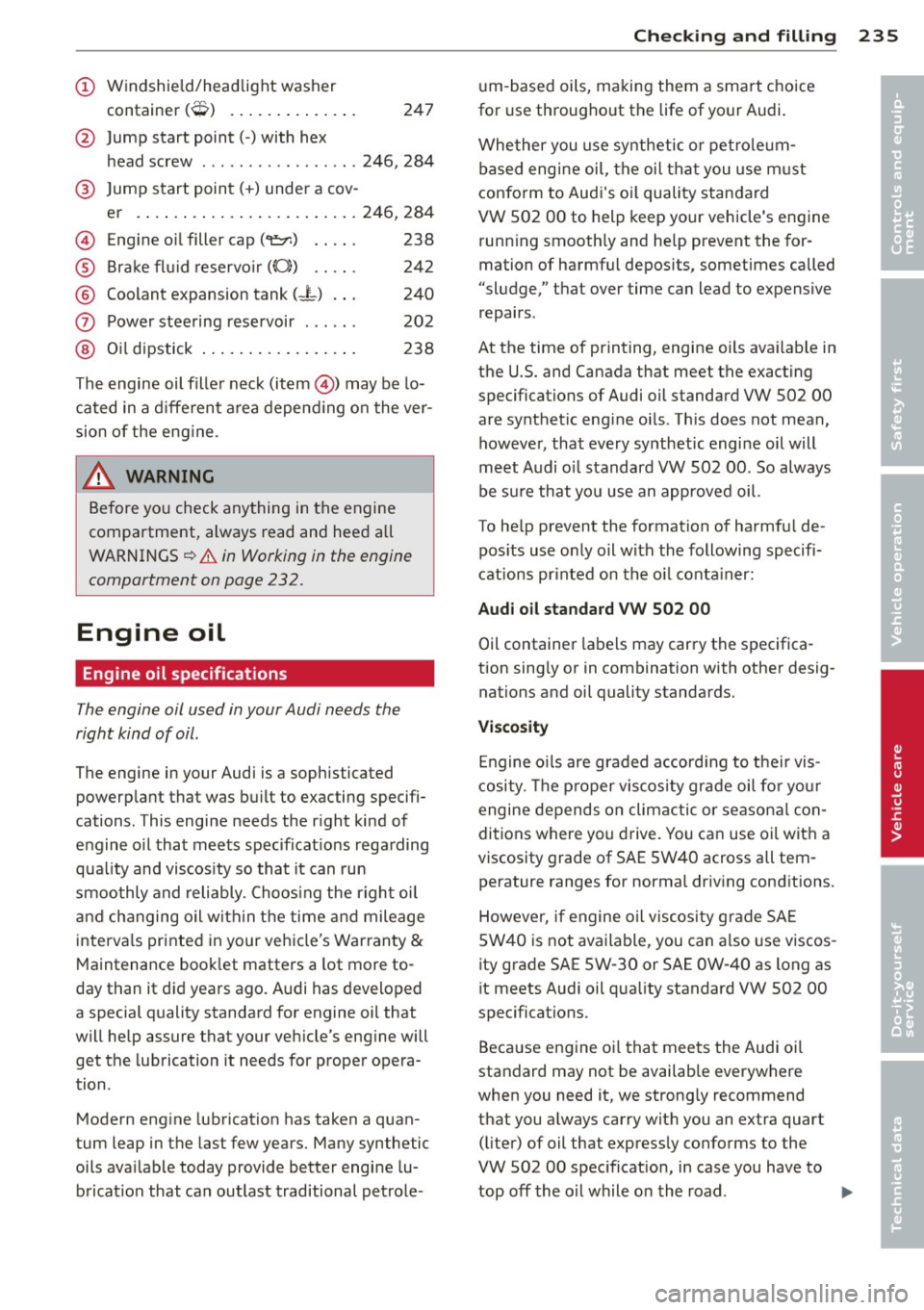
(!) Windshield/headlight washer
t .
(~ ) con ainer ,..., .. .... ... ... . . 247
@ Jump start point( -) with hex
h ead screw ............... .. 246, 284
® Jump start point( +) under a cov-
er . ..... .. ... .. ..... ... .. . 246, 284
@ Engine oil filler cap(~) . . . . . 238
® Brake fl uid reservo ir ((0)) . . . . . 242
® Coolant expansion tank (-L) . . . 240
0 Power steering reservoir . . . . . . 202
@ Oil dipstick . . . . . . . . . . . . . . . . . 238
The engine oil fille r nec k (item @) may be lo
cated in a d ifferent a rea depend ing o n the ver
sion of the eng ine .
A WARNING
Before yo u check any thing in the engine
compartment, always read and heed all
WARNINGS
~ &. in Working in the engine
compartment on page 232.
Engine oil
Engine oil specifications
The engine oil used in your Audi needs the
right kind of oil.
-
The engine in your Audi is a sophisticated
powerp lant that was bu ilt to exacting specifi
cations. This engine needs the r ight kind of
engine o il that meets specificat ions rega rding
qua lity and viscos ity so that it can run
smoothly and reliably . Choos ing the righ t oi l
and ch anging oil with in t he time and mileage
inte rva ls printed in your veh icle's Warranty
&
M aintenance book let matters a lot more to
day than it d id years ago. A udi has developed
a special quality standard for engine oil that
will he lp assure that your veh icle's eng ine will
get the lubrication it needs for prope r opera
tion .
M odern eng ine lubrication has taken a quan
tum leap in the last few years. Many synthetic
oils ava ilable today provide better engine lu
brication that can outlast traditional pet role -
Checkin g and fillin g 235
um -based oils, ma king them a smart cho ice
for use throughout the life of your Audi.
Whether you use sy nthetic o r pe trole um
based eng ine oil, the oil tha t you use m ust
confo rm to Aud i's oi l quality standard
VW 502 00 to help keep your vehicle's engine runn ing smooth ly and he lp prevent the for
mation of harmful deposits, sometimes called
"sludge," that over time can lead to expensive
repairs .
At the time of printing, engine oils ava ilab le in
the U.S. and Canada that meet the exact ing
specifications of Audi oi l standard VW 502 00
are synthet ic eng ine o ils . Th is does not mean,
howeve r, that every sy nthetic engi ne oil will
meet A udi o il standard VW 502 00 . So always
be s ure that yo u use an approved oil.
To he lp prevent the formation of harmfu l de
pos its use on ly o il wi th the following specifi
cat ions pr inted on th e oil conta iner:
Audi oil standard VW 502 00
Oil container labe ls may car ry the specifica
tion sing ly or in combination with othe r desig
nations and oil quality standards.
Viscosity
E ngine o ils are graded a ccord ing to the ir vis
cosi ty . T he p roper viscos ity grade oil fo r yo ur
engine depends on climactic o r seasona l con
ditions where yo u drive. You can use oi l wit h a
viscosity grade of SAE 5W40 across all tem
perature ranges for norma l driv ing cond itions.
However, if engine oil viscosity g rade SA E
5W40 is not available, you can also use viscos
ity grade SAE 5W -30 or SAE OW -40 as long as
it meets Audi oil q ua lity standard VW 502 00
specifications.
Because eng ine o il tha t meets the Audi oi l
standard may not be availab le everywhere
when you need it, we strong ly recommend
that you a lways carry wit h you an extra quart
( li ter) of oil that express ly conforms to the
VW 502 00 spec if icat ion, in case you have to
top off the o il while o n the road . .,..
•
•
Page 252 of 318
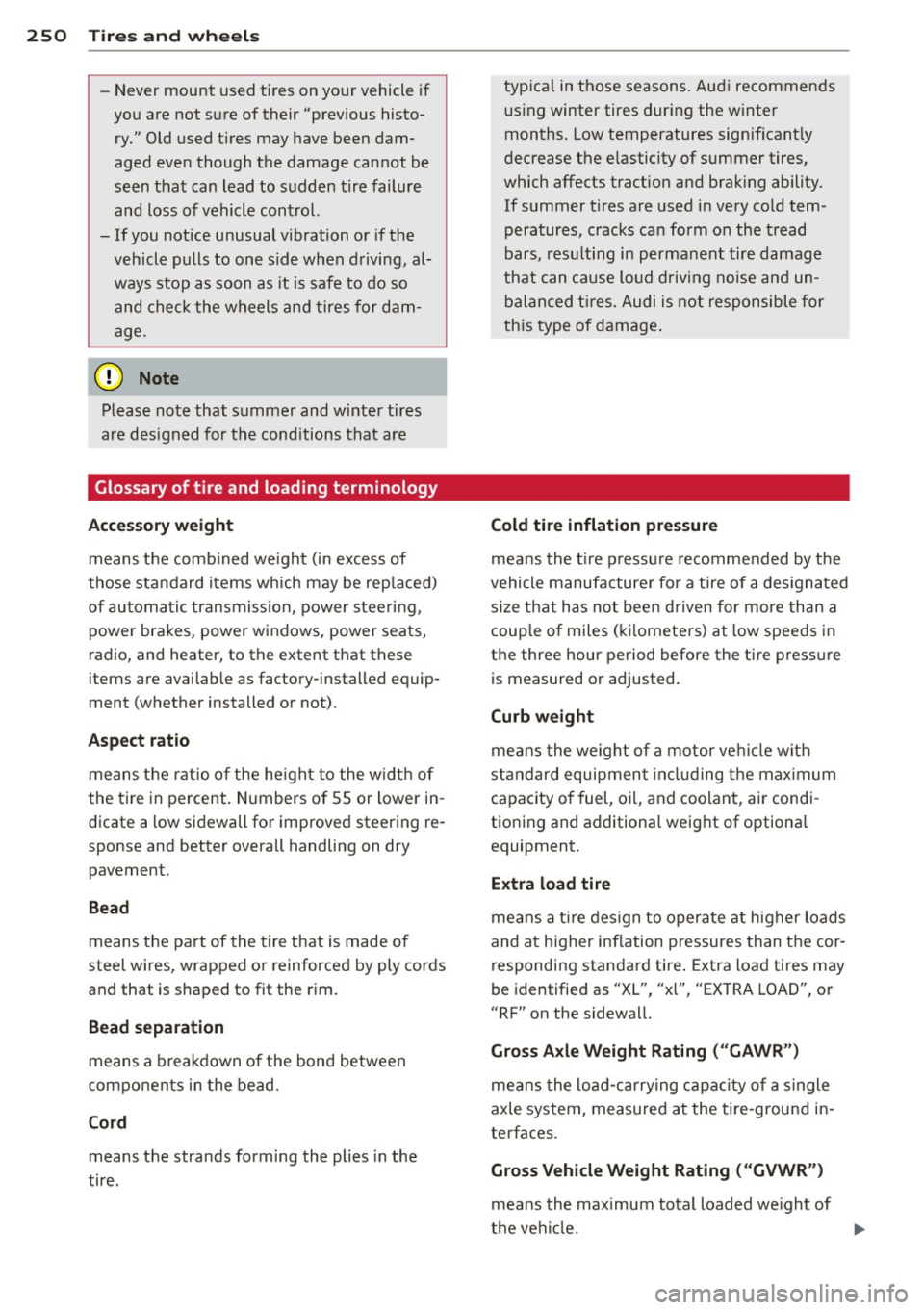
250 Tire s and wheel s
-Never mount used tires on yo ur vehicle if
you are not sure of their "previous histo
ry." Old used tires may have been dam
aged even though the damage cannot be
seen that can lead to sudden t ire failure
and loss of vehicle control.
- If you notice unusual vibration or if the
vehicle pulls to one side when driving, al
ways stop as soon as it is safe to do so
and check the wheels and tires for dam
age.
(D Note
Please note that summer and wi nte r tires
are designed for the cond itions that are
Glossary of tire and loading terminology
Accessory weight
means t he comb ined we ight (in excess of
those sta ndard items which may be rep laced)
of au toma tic tra nsmission, power steer ing,
power brakes, power windows, power seats,
radio, and heater, to the extent that th ese
items are availab le as factory -installed equip
ment (whether installed or not) .
Aspect ratio
means t he ratio of the he ight to the w idth of
the tire in percent . Numbers of 55 or lower in
dicate a low sidewall for improved steering re
sponse and better overall handling on dry pavement .
Bead
means the part of the ti re that is made of
steel wires, wrapped or reinforced by ply cords
and that is shaped to fit the rim.
Bead separation
means a b reakdown of the bond between
components in the bead.
Cord
means the strands forming the plies in the
tire . typ
ica l in those seasons . Aud i recommends
using winter tires during the winter
months . Low temperatures signif icant ly
decrease the e lasticity of summer tires,
which affects tract ion and brak ing ability.
If summer tires are used in very co ld tem
peratures, cracks ca n form on the tread
bars, res ulting in permanent tire damage
that can cause loud driving no ise and un
balan ced t ires. Audi is not responsible for
th is type of damage .
Cold tire inflation pressure
means the tire p ressu re recommended by t he
vehicle manufacturer fo r a tire of a des igna ted
s iz e that has not bee n driven for more than a
coup le of miles (k ilometers) at low speeds in
t h e three hour period before the tire pressure
is measured or adjusted.
Curb weight
mea ns the we ight of a motor ve hicle with
standard equipment in cl uding the max imum
capacity of fuel, oil, and coolant, air condi
tioning and additional weight of optiona l
equipment.
Extra load tire
me ans a t ire design to operate at higher loads
and at h igher inflation pressures than the cor
responding standard tire . Extra load tires may
be identified as "XL", "x l" , "EXTRA LOAD", or
"RF" on the sidewall.
Gross A xle Weight Rating ("GAWR ")
means the lo ad -c a rry ing c apac ity of a s ingle
axle system , measured a t the tire-ground in
terfaces.
Gross Vehicle Weight Rating ("GVWR ")
mea ns the maximum total loaded we ight of
t h e ve hicl e. .,.
Page 282 of 318
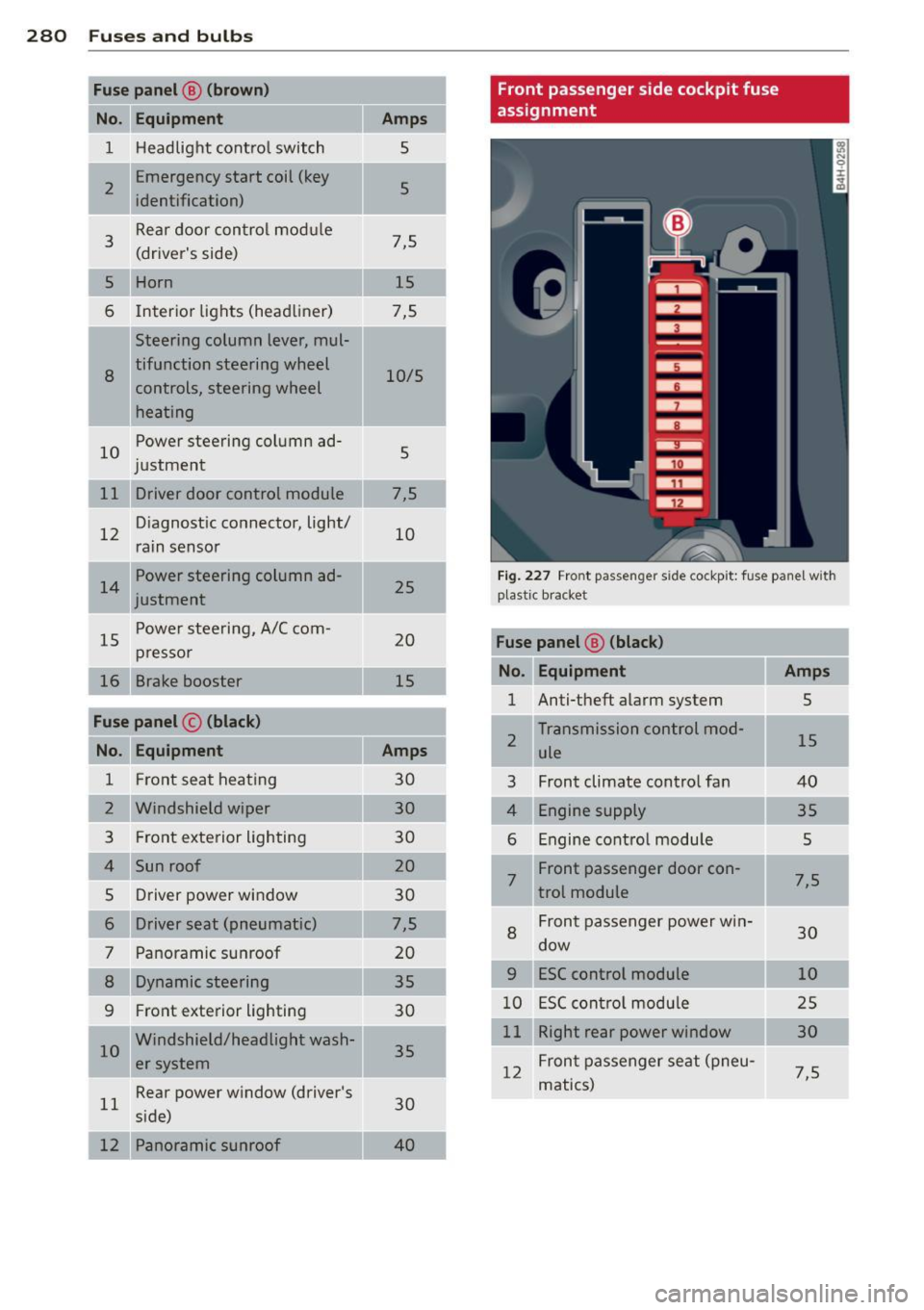
280 Fuses and bulbs
Fuse panel @ (brown)
No. Equipment
1 Headlight control switch
2 Emergency start coil (key
identification)
3 Rear door
control module
(driver's side)
5 Horn
6 Interior lights
(headliner)
Steering column lever, mul-
8
tifunction steering wheel
controls, steering wheel
I heating
10 Power steering column ad-
justment
11 Driver door control module
12 Diagnost
ic connector, light/
rain sensor
14 Power steering column ad-
justment
15 Power
steering, A/C com-
pressor
16 Brake booster
Fuse panel © (black)
No. Equipment
1 Front seat heating
2 Windshield wiper
3 Front exterior lighting
4 Sun roof
5 Driver power window
6 Driver seat (pneumatic)
7 Panoramic
sunroof
8 Dynamic steering
9 Front exterior lighting
10 Windshield/headlight
wash-
er system
11 Rear power window (driver's
side)
Panoramic sunroof
Amps
5
5
7,5 15
7,5
10/5
5
7,5 10
25
20 15
Amps
30
30
30 20
30
7,5
20
35
30
35
30
40
Front passenger side cockpit fuse
assignment
Fig. 227 Front passe nger side cockpit: fuse pane l with
plastic bracket
Fuse panel ® (black)
No. Equipment Amps
1 Anti-theft alarm system
5
2 T
ransmission control mod-
15
ule
3 Front climate control fan 40
4 Engine supply 35
6 Engine
control module
5
7 Front passenger door con-
7,5
trol module
8 Front passenger
power win-
30
dow
9 ESC control module 10
10 E5C control modu le 25
11 Right rear power window
30
12 Front passenger
seat (pneu-
7,5
matics)
Page 306 of 318

304 Index
Declaration of compliance
Adaptive cruise control ............. 299
Audi side assist ................... 299
Cell phone package ....... .. .. .... . 299
Convenience key .......... .... .... . 299
Electronic immobilizer ......... .. ... 299
H omelink ® universal remote control .. 299
Remote control key ........... .. .. . 299
DEF What does this mean when it appears in
the trip odometer display? ..... .. .. .. 26
Defective light bulb warning . . . . . . . . . . . 21
Defrosting (windows) ....... .. .. .. .. . . 80
Deluxe automatic climate control . . . . . . . 79
Determining correct load limit ... .. .. . 258
Dig ital compass ..... ..... ... .. .. .. .. 55
Dimensions
. ...... ........ .. .. .... . 291
Dimming the rearview mirror .. .. .. .. . . 54
Distance . . . . . . . . . . . . . . . . . . . . . . . . . . . 24
Door/rear lid warning . . . . . . . . . . . . . . . . . 23
Doors M echanical ch ild safety lock .. .. .... .. 40
Power child safety lock .... .. .. .. .. .. 40
Driver information system CD/radio display . . . . . . . . . . . . . . . . . . . . 23
Door/rear lid warning . . . . . . . . . . . . . . . 23
Eff iciency program . . . . . . . . . . . . . . . . . . 25
Ex terior temperature display . .. .. .. . . 23
On-boa rd comp uter ....... .. .. .. .. . .
Driver seating position
drive select
adaptive air suspension/sport ... .. .. .
Adaptive dampers ........ .. .. .... .
Curve light .. ... .... ..... .. .. .. .. .
Dynamic steering ............. .. .. .
Engine sound ......... .... ... .. .. .
Safety belt tensioner ...... .. .. .... .
Sport differential ......... .. .. .. .. .
Drive select
.. ... .. ..... ... .... .. .. .
Driving safely ... ........ .. .. .. .... .
Driving through water 24
135
109
109
109
109 109
109
109
109
134
208
Driving time . . . . . . . . . . . . . . . . . . . . . . . . 24
Duplicate key . . . . . . . . . . . . . . . . . . . . . . . 30
Dust filter
refer to Pollutant filter (automatic A/C
system) .. .. ... .......... .. .. .. .. .. 78
Dynamic steering . . . . . . . . . . . . . . . 22, 109
E
Easy entry fea ture . .... .......... .. .. . 82
EDL
refer to Electronic differential lock .. .. 198
Efficiency program . . . . . . . . . . . . . . . . . . . 25
Fuel economy messages . . . . . . . . . . . . . 25
Other equ ipment . .......... ...... .. 25
E lectrica l accessories (sockets) . . . . . 67, 73
El ectromechanical pa rking brake
Emergency b raking ............ .. .. . 87
Operation . . . . . . . . . . . . . . . . . . . . . . . . . 85
Parking ... .... .. .. ... ........ .. .. . 86
Releasing and closing ............ .. . 85
Starting assist . . . . . . . . . . . . . . . . . . . . . 86
Starting from rest ............. .... . 86
Starting off w ith a trailer ........ .. .. . 87
Warning/ind icator lights .. ... ..... .. . 15
E lectronic differential lock ........ .. .. 198
El ectronic differential lock (EDL)
Warning/indicator lights .......... .. . 19
Electronic immob ilizer . . . . . . . . . . . . 26, 31
Electronic power control (EPC)
warning/indicator light . . . . . . . . . . . . . . 20
El ectronic speed limit er .......... .. .. . 29
Electronic Stabilization Control (ESC) ... 198
Warning/indicator lights .. ... ..... .. . 18
Emergency actuation Doors . ... .... .. .. ... .......... .. . 36
Luggage compartment lid ....... .... . 39
Parking lock ..... ............. .... 120
Power sunroof ... ..... ........... .. 43
Emergency braking ... ........... .. .. . 87
Eme rgency flasher .... .. ... ..... .. .. . 46
Warning/indicator lights .......... .. . 22
Emergency operation
Panoram ic sunroof ..... .. ... ..... .. .
Sun shade (roof) . ................ . .
Emergency starting 44
44
284
Emergen cy to wing ................ .. 286
Emergency warn ing triangle .. ... ... .. 270
Energy management ............ .. .. 203
En gine
Compartment .. .. ... .......... ... .
Coolant ... .. .. .. ............. .. . .
Data
. .. .. .... .. ... .. .......... ..
234
240
292
Start-Stop-System .. ........... .. .. . 87
Page 309 of 318
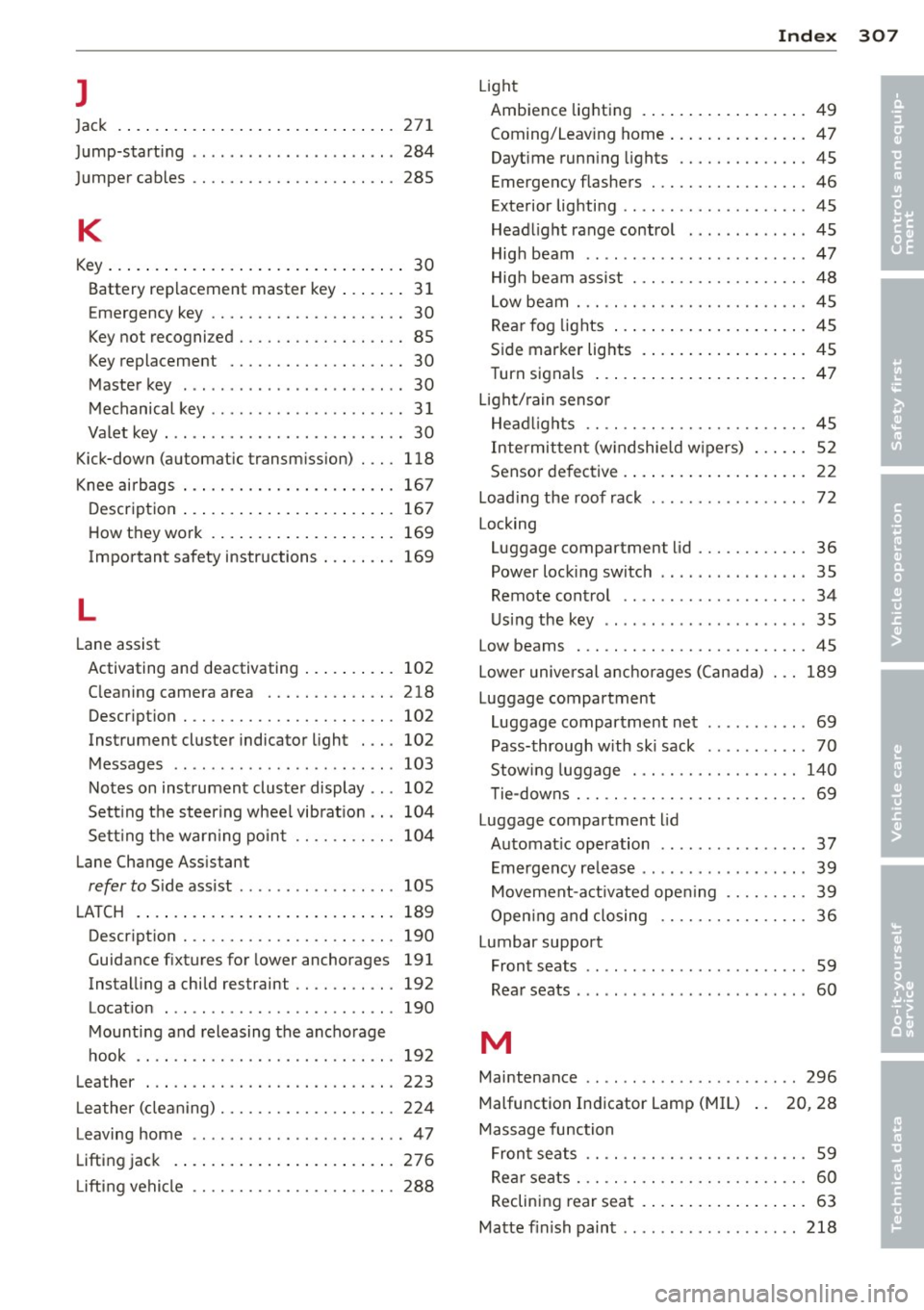
l
Jack . ..... .. .. ..... ..... ... .. .. ... 271
J ump-starting ..... ..... ... .. .. .. .. . 284
Jumper cables ............. .... .. .. . 285
K
Key ... .. .. .. .. .. .. .. .... ... .. .. .... 30
Battery replacement master key . . . . . . . 31
E mergency key . . . . . . . . . . . . . . . . . . . . . 30
Key not recogni zed . . . . . . . . . . . . . . . . . . 85
Key replacement . . . . . . . . . . . . . . . . . . . 30
Master key . . . . . . . . . . . . . . . . . . . . . . . . 30
Mechanical key . . . . . . . . . . . . . . . . . . . . . 31
Valet key . .. ......... ........ .. .. .. 30
K ick-down (automat ic transm ission) . .. . 118
Knee airbags ... .. .. .. .... ... .. .... . 167
Description ... .. .. .. .... ... .. .. ... 167
H ow they work . .. ..... ... .. .. .. .. . 169
Important safety instructions . .. .. .. . 169
L
Lane assist
Activating and deactivating ... .. .. .. . 102
C leaning camera area ..... .. .. .. .. . 218
Descr ipt ion . ............. .... .. ... 102
Instrument cluster indicato r light . .. . 102
Messages .. ... .. .. ...... .. .. .. .. . 103
Notes on instrumen t cluster display .. . 102
Sett ing the steering wheel vib rat ion .. . 104
Sett ing t he war ning po in t .. .. .. .. .. . 104
Lane Change Ass istant
refer to S ide ass ist . ....... .. .. .. .. . 105
L A T CH .... .. .. .... .. .... ... .. .. ... 189
Description . ............. .... .. .. . 190
Guidance fixtures for lower anchorages 191
Instal ling a chi ld restraint .. .. .. .. .. . 192
Locat ion
Mount ing and releasing the ancho rage
hook .. .. .. .... ... ... ..... .. .. .. .
Leather 190
19 2
223
L ea ther (cle aning) .......... .. .. .. ... 224
Leaving home ..... .. ...... .. .. .. .. .. 47
Lifting jack . ... ... ..... ... .. .. .. ... 276
Lifti ng vehicle .. ........... .. .. .. ... 288
Inde x 307
Light
Ambience lighting . .. ... .... ... .. .. . 49
Coming/Leav ing home .. ..... ... .. .. . 47
Daytime runn ing lights ............. . 45
Emergency flashers ................ . 46
Exterior lig hti ng ... ................. 45
Head light range control .. .. ... ... .. . 45
Hig h beam ....... ...... ........... 47
Hig h beam assist . .. . .............. . 48
L ow be am . .. .. .. .... ........... .. . 45
Rear fog lights ... .. .. .. ...... ... .. . 45
Side marker lights . .. .. ..... ... .. .. . 45
Turn signals ... .. .. . ... ...... ... .. . 47
L ight/ rain senso r
Head lights .. .. .. .... ........... .. . 45
Intermit ten t (w indshie ld w ipers) ... .. . 52
Senso r de fec tive . . . . . . . . . . . . . . . . . . . . 22
Load ing the roof rack ............... .. 72
Locking Luggage compartment lid ....... .... . 36
Power locking switch .... ......... .. . 35
Remote contro l . . . . . . . . . . . . . . . . . . . . 34
Us ing the key .. ... ...... ........... 35
Low beams
. .. .. .. ................. . 45
Lower unive rsal ancho rages (Can ada) 189
Luggage compartment Luggage compartment net . . . . . . . . . . . 69
Pass-through w ith ski sack . . . . . . . . . . . 70
Stow ing luggage . .... ............. 140
T ie-downs . . . . . . . . . . . . . . . . . . . . . . . . . 69
Luggage compartment lid
Automat ic operation .. .. ...... .... .. 37
Emergency re lease ................ .. 39
Movement-a ct ivated ope ning .... .. .. . 39
Open ing and closing ............. .. . 36
Lumbar support Front seats . . . . . . . . . . . . . . . . . . . . . . . . 59
Rea r seats ........ ...... ........... 60
M
Maintenance .. .. .. .. . .. .... .... .. .. 296
Malfunction Indicator Lamp (MIL) 20 , 28
Massage fu nction
Fron t seats . . . . . . . . . . . . . . . . . . . . . . . . 59
Rear seats . . . . . . . . . . . . . . . . . . . . . . . . . 60
Reclining rear seat . .. .. ..... ... .. .. . 63
Matte f inish paint .. .. . .. .. .. ... ... .. 218
•
•
Page 314 of 318
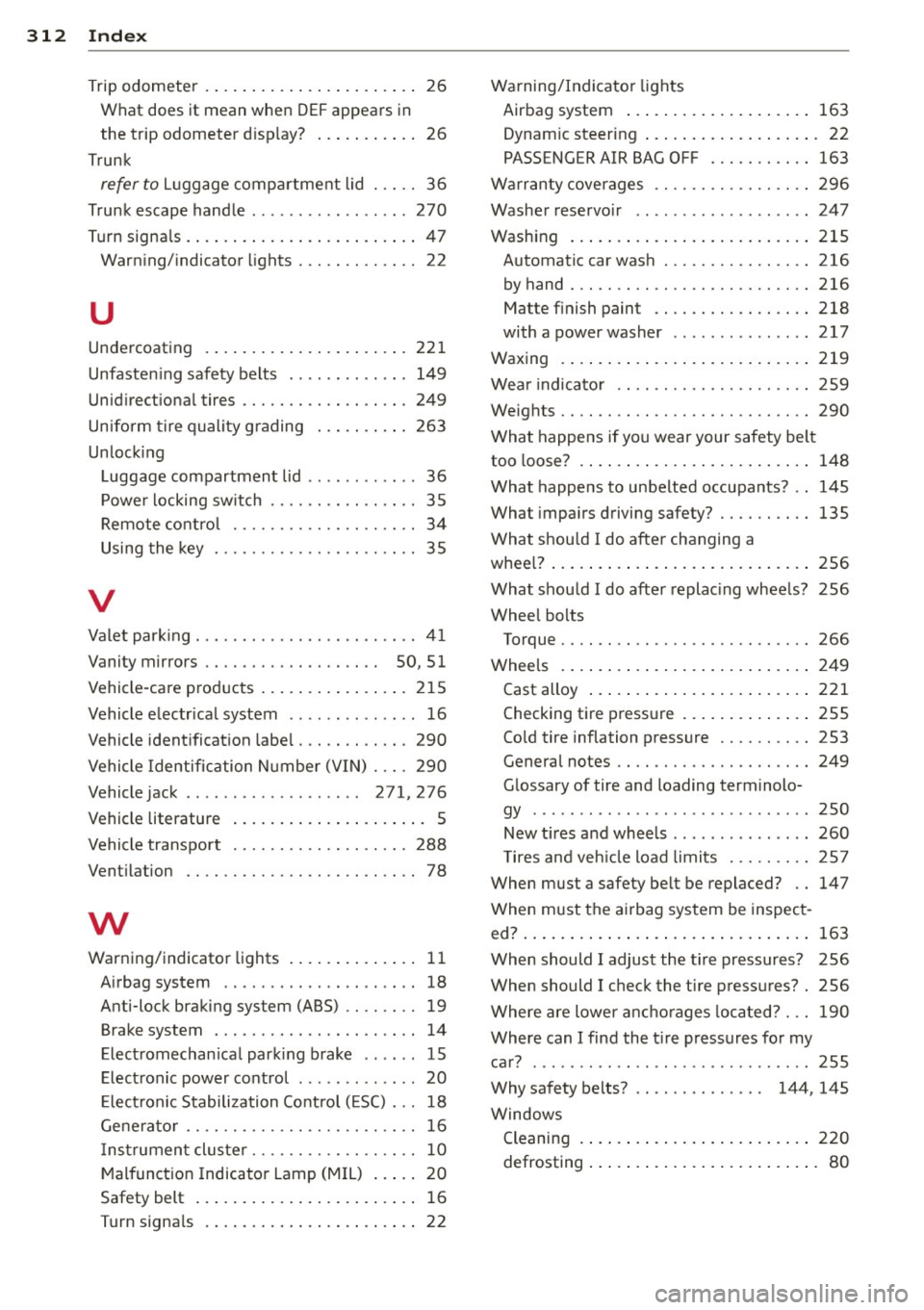
312 Index
Trip odometer . . . . . . . . . . . . . . . . . . . . . . . 26
What does it mean whe n DEF appears in
the trip odometer d isp lay? ... .. .... . . 26
T runk
refer to L uggage compa rtment lid ... .. 36
Trunk escape hand le ..... .... ... .. .. . 270
Turn signa ls . .... . ...... ... .. .. .... .. 47
Warn ing/ indicator lights ... .. .. .... .. 22
u
Unde rcoating . .. ..... ... .. .. .. .... . 221
Unfasten ing safety belts .. .. .. .. .. .. . 149
Unid irect iona l tires ......... .. .. .... . 249
Unifo rm tire q uality g rading ... .. .... . 263
Unlock ing
L uggage compartment lid ...... .. .... 36
P owe r locking sw itch .... .. .. .. .. .. . . 35
Remote contro l . . . . . . . . . . . . . . . . . . . . 34
Using the key .......... .. .. .. .. .. .. 35
V
Valet park ing .............. .. .. .. .. .. 41
Vanity mirrors . . . . . . . . . . . . . . . . . . . 50, 51
Vehicle -care products .. ... .. .. .. .... . 215
Vehicle electr ical system .. .. .. .. .. .. .. 1 6
Vehicle ident ificat ion labe l ... .. .. .. .. . 290
Vehicle Identification N umbe r (VIN) . .. . 290
Vehicle jack . . . . . . . . . . . . . . . . . . . 271, 276
Vehicle literature . . . . . . . . . . . . . . . . . . . . . 5
Vehicle transpo rt .......... .. .. .. .. . 288
Vent ilation .... ........... .. .. .... .. 78
w
Warning/indicato r lights . ... .. .. .... . . 11
A irbag system ........... .. .. .. .. .. 18
Anti-lock braking system (ABS) .. .. .. . . 19
Brake system . ...... ... .. .. .. .. .. .. 14
Elect romechan ica l park ing brake .. .. .. 15
E lect ron ic power co ntro l . . . . . . . . . . . . . 20
E lect ron ic Stabilization Co ntrol ( ESC) . . . 18
Genera to r .... ............. ...... .. 16
I ns trumen t clus ter ........ .. .. .... .. 10
M alfunct ion Indicator Lamp (M IL) . . . . . 20
Safety belt .... . ...... ... .. .. .... .. 1 6
T u rn signa ls . .. ..... ... .. .. .. .... .. 22 Warning/Indicator
lights
Airbag system ... .. ... ..... ... .. .. 163
Dynam ic steering .... .. ..... ... .. .. . 22
PASS ENGER AIR BAG OFF ....... .... 163
W arran ty coverages ............. .... 296
Washer reservo ir .. ..... ......... ... 247
Washing ... .... .. .. ... ..... ... .. .. 215
Automatic car wash ............ .... 216
by hand . .. .. .. .. ............. .. .. 216
Ma tte finish paint ... .......... .. .. 218
with a power washer . . . . . . . . . . . . . . . 217
Waxing . ... .... .. .. ... ..... ... .. .. 219
Wea r indica to r ................. .. .. 259
Weights .... .... ................... 290
What happens if yo u wear your safety belt
too loose? . ..... .. .. .... .... ... .. .. 148
What happens to unbe lted occupants? .. 145
What impairs driving safety? .... .. .... 135
What shou ld I do after changing a
whee l? ... .. .... .. ... .. ..... ... .. .. 256
What shou ld I do after replac ing whee ls? 256
Wheel bolts Torque .... .... .. ............. .... 266
Whee ls . ... .... .. .. ... ..... ... .. .. 249
Cast alloy ..... .. ... .. ..... ... .. .. 221
Checking tire p ress ure .. ... ... .. .. .. 255
Co ld tire inflation pressure ...... .... 253
General notes .. .. ............. .. .. 249
G lossary of tire and loading term inolo-
gy ........ ... .. .. ............... 250
New t ires and whee ls ........ ...... . 260
T ires and veh icle load limits ..... .. .. 25 7
When must a safety be lt be replaced? .. 147
When must the a irbag system be inspec t-
ed? ... ... .. .. .. .. ... .. .. ..... ... .. 163
When should I adjust the tire pr essures? 256
When should I check the tire press ures? . 256
Where are lower ancho rages loca ted? ... 190
Where can I find the t ire pressures for my
ca r? .. ...... ... .. .. ... ....... ... .. 255
Why safety belts? . . . . . . . . . . . . . . 144, 145
Windows Cleaning . ..... .. ... .. ..... ... .. .. 2 20
defrosting ..... .. .. ... ..... ... .. .. . 80